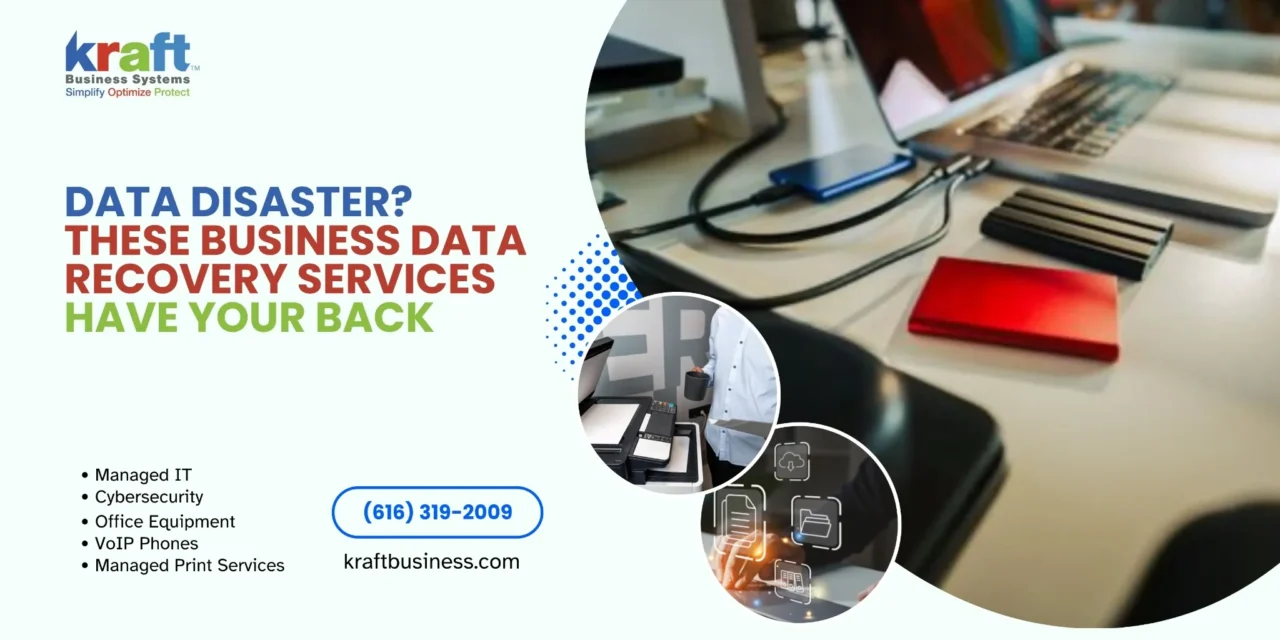Business data recovery services are specialized companies that retrieve lost, corrupted, or inaccessible data from damaged storage devices using professional-grade equipment and techniques. Here’s what you need to know:
Top Business Data Recovery Services Include:
- DriveSavers – 97% customer satisfaction, 35+ years experience
- Ontrack – Global leader, 120+ petabytes recovered
- Secure Data Recovery – 96% success rate, SSAE 18 certified
- ACE Data Recovery – 98% success rate, Class 100 cleanroom
- Gillware – 100,000+ devices recovered since 2004
Key Service Features:
- ISO Class 5 cleanroom facilities
- “No Data, No Charge” guarantees
- 24/7 emergency response
- HIPAA and SOC 2 compliance
- Free diagnostics and shipping
Data loss hits businesses harder than ever. A single server crash can cost your company thousands in downtime, while ransomware attacks have increased 41% year-over-year. The scary truth? 93% of companies that lose data for 10 days or more file for bankruptcy within one year.
Professional recovery services now achieve 96-98% success rates using advanced techniques like cleanroom surgeries and proprietary firmware tools. They handle everything from clicking hard drives to encrypted RAID arrays that your IT team can’t touch.
But here’s what most business owners don’t realize: the first 48 hours after data loss determine your recovery chances. Try the wrong software or power on a damaged drive, and you might turn a $500 recovery into a $5,000 nightmare.
The good news? Today’s recovery services offer transparent pricing, secure handling, and service guarantees that remove the guesswork. Whether you’re dealing with a crashed server or a coffee-soaked laptop, professional help is just a phone call away.
Why Business Data Recovery Services Matter in 2025
The cost of data loss keeps climbing, and it’s not just about losing files anymore. When your business loses critical data, you’re looking at a perfect storm of regulatory fines, crippling downtime costs, and potential business closure.
Regulatory penalties have become absolutely brutal. Healthcare companies face HIPAA violations that can cost up to $1.5 million per incident. If you’re handling European customer data, GDPR fines have topped €50 million for major breaches. Even smaller violations can drain your bank account faster than you’d expect.
The downtime numbers are even scarier. Manufacturing companies hemorrhage an average of $50,000 every hour their production systems stay down. Financial services firms can lose $300,000 hourly during trading hours. Even if you run a smaller operation, you’re probably looking at around $8,000 per hour when your systems crash.
Here’s the good news: business data recovery services have gotten incredibly effective. Professional providers now achieve 96-98% success rates across all types of storage devices. This isn’t luck – it’s the result of serious investment in specialized equipment and controlled environments.
Most major recovery companies operate ISO Class 5 cleanrooms with fewer than 10 particles per cubic foot of air. These sterile environments let technicians safely crack open hard drives and perform microscopic repairs without dust contamination destroying your data.
The “No Data, No Charge” guarantee has become standard practice, which takes the financial risk out of recovery attempts. You only pay when they actually get your data back. This policy change has made professional recovery accessible to businesses of all sizes, not just Fortune 500 companies.
Security certifications matter more than ever. SOC 2 Type II audits ensure providers handle your data with bank-level security protocols. HIPAA compliance protects healthcare information throughout the entire recovery process. These aren’t just fancy badges – they represent rigorous third-party validation of how seriously these companies take data security.
| Service Tier | Timeline | Use Case | Success Rate |
|---|---|---|---|
| Emergency | 24-48 hours | Mission-critical systems | 90-95% |
| Priority | 2-5 business days | Important business data | 95-98% |
| Standard | 5-14 business days | General recovery needs | 96-98% |
Business Data Recovery Services 101
Business data recovery services involve professional retrieval of digital information from damaged, corrupted, or completely inaccessible storage devices. This goes way beyond what your IT team can handle with basic recovery software downloaded from the internet.
Recovery experts make a crucial distinction between physical and logical data loss. Physical loss happens when hardware components actually break down – think hard drives making that dreaded clicking sound, burnt circuit boards, or devices that took a swim in coffee. These situations require cleanroom environments and specialized tools to repair or work around damaged components.
Logical loss involves software-related problems like corrupted file systems, accidental deletions, or ransomware that encrypts everything. While these might seem simpler to fix, they often require sophisticated techniques to rebuild file structures without making things worse.
Modern businesses depend on complex storage systems that demand specialized expertise. RAID arrays use multiple drives working together, requiring deep understanding of how data gets striped across drives and how parity calculations work. Network Attached Storage (NAS) systems often run proprietary file systems that standard recovery tools can’t even read. Solid State Drives (SSDs) present unique challenges because of wear leveling algorithms and encryption controllers built right into the hardware.
Encryption handling represents a critical difference between amateur and professional services. Professional providers maintain relationships with hardware manufacturers, allowing them to work with encrypted drives without compromising your security. They understand firmware-level encryption, BitLocker implementations, and enterprise key management systems that would stump most IT departments.
Chain-of-custody documentation ensures your recovered data remains legally admissible if you’re facing litigation or regulatory investigations. Professional services maintain detailed logs of every single action taken on your storage device, creating an unbroken record from the moment they receive it until they return your data.
Business Data Recovery Services vs DIY Software
The temptation to try recovery software before calling professionals makes perfect sense – it seems faster and cheaper. Unfortunately, this approach often transforms a recoverable situation into permanent data loss.
Professional services achieve those impressive 96-98% success rates, while consumer software typically succeeds in only 30-50% of cases. This dramatic difference comes from several factors that DIY solutions simply can’t address.
Recovery software becomes completely useless when dealing with physical damage. When your hard drive starts making clicking sounds or won’t spin up at all, no amount of software will help. These symptoms indicate mechanical failure that requires cleanroom intervention. Running software on a physically damaged drive often causes additional damage, reducing your chances of professional recovery.
The risk of overwrites represents the biggest danger of DIY attempts. Recovery software writes temporary files and scanning logs directly to your storage device during operation. Each write operation potentially overwrites recoverable data forever. Professional services create forensic images first, working only on copies to preserve your original data.
Firmware damage affects many modern storage devices, especially SSDs and enterprise drives. Consumer software lacks the tools to even diagnose firmware corruption, let alone repair it. Professional services maintain extensive libraries of firmware modules and specialized equipment for low-level repairs that most people have never heard of.
The limited scope of freeware becomes obvious with complex storage systems. RAID arrays, virtual machines, and database files require specialized knowledge that generic software doesn’t possess. Professional services employ engineers with decades of experience working on specific storage technologies.
Time pressure often leads to terrible decisions. Businesses facing critical downtime may rush through multiple software attempts, progressively damaging their data with each failed try. Professional services offer emergency response options that often prove faster than extended DIY efforts that go nowhere.
Choosing the Right Recovery Solution for Your Organization
When data disaster strikes, you’re facing a critical decision that could make or break your recovery chances. The good news? Understanding your options beforehand takes the panic out of the process and helps you choose the best path forward.
In-lab recovery represents the heavyweight champion of data rescue. This approach handles everything from clicking hard drives to corrupted RAID arrays that would make your IT team break out in a cold sweat. You’ll need to ship your device to the recovery facility, but you’re getting the highest success rates available. Most reputable providers offer free diagnostics, giving you a detailed roadmap before you commit to anything.
On-site recovery brings the cavalry directly to your door. This option shines when you’re dealing with massive storage systems or ultra-sensitive data that absolutely cannot leave your building. Think enterprise RAID shelves the size of refrigerators or air-gapped networks that have never seen the internet. Response times typically range from same-day service in major cities to 24-48 hours in more remote areas.
Remote imaging offers the speed of light approach when your storage devices are still accessible but your data seems to have vanished. Recovery specialists connect through secure VPN tunnels, creating exact copies of your drives for detailed analysis. This method works beautifully for logical failures where the hardware is fine but something went wrong with the software side.
Service Level Agreements remove the guesswork from emergency planning. Emergency 24/7 services guarantee immediate response with round-the-clock work until your data comes home. Standard services provide predictable timelines with regular updates, while expedited options split the difference between cost and urgency.
The beauty of professional business data recovery services lies in their transparency. Free diagnostics mean you’ll know exactly what happened to your data and what recovery options make sense for your situation. No surprises, no hidden costs, just clear answers when you need them most.
In-Lab Cleanroom Recovery
Step inside a professional data recovery facility, and you’ll feel like you’ve entered a space station. Class 100 cleanroom chambers maintain fewer than 100 particles per cubic foot of air – that’s cleaner than most hospital operating rooms. This sterile environment isn’t just for show; even a single dust particle can destroy data on modern hard drives.
The real magic happens with donor parts inventory. When your drive’s read/write head crashes, technicians need matching components from identical drives. Major recovery facilities maintain warehouses full of donor drives, organized by model, firmware version, and manufacturing date. It’s like having the world’s most specialized auto parts store.
Microscopic repairs require steady hands and extraordinary skill. Technicians work under high-powered microscopes, manipulating components smaller than human hair. Head replacement procedures involve precision tools that can adjust alignment to within nanometers – that’s roughly 100,000 times thinner than a sheet of paper.
Imaging first protocols protect your original data throughout the entire process. Before touching anything, technicians create sector-by-sector copies of all readable portions. Every subsequent repair attempt works on these copies, leaving your original drive untouched. Think of it as making a backup before trying to fix the backup.
Environmental controls extend far beyond air filtration. These facilities maintain precise temperature and humidity levels while preventing static electricity buildup. Specialized workstations provide vibration-free platforms for delicate procedures – critical when working with storage densities exceeding one terabit per square inch.
Dust mitigation involves multiple layers of protection that would make a germaphobe proud. Personnel wear full cleanroom suits, pass through air showers, and follow strict sterilization protocols. These procedures might seem excessive until you realize that modern drives pack more data into a square inch than seemed possible just a few years ago.
On-Site & Remote Enterprise Recovery
Some data recovery jobs are simply too big to ship. Large RAID shelves can weigh hundreds of pounds and contain dozens of drives in complex configurations. Moving these systems risks additional damage, while on-site recovery preserves the original environment where everything was working perfectly.
Storage Area Networks and VM hosts represent the crown jewels of enterprise infrastructure. These systems often contain terabytes of data across multiple virtual machines, databases, and application servers. Professional services bring portable cleanroom equipment and specialized tools directly to your data center, minimizing downtime and transportation risks.
Encrypted arrays demand extra careful handling to preserve key management systems. Enterprise encryption involves hardware security modules, complex certificate hierarchies, and key escrow systems that took months to configure properly. Recovery specialists understand these systems and work within existing security frameworks without compromising your data protection.
Secure VPN tunnels enable lightning-fast remote diagnosis without exposing sensitive information. Recovery experts can connect to your systems through encrypted channels, performing initial assessments and creating forensic images for detailed analysis. You get the speed of remote access combined with professional-grade security.
Air-gapped copies provide ultimate security for organizations with strict data handling requirements. Some recovery operations require complete network isolation to meet compliance standards. Professional services can create standalone recovery environments, ensuring your data never leaves your premises during the entire recovery process.
Service-Level Agreements & “No Data, No Charge” Policies
Standard service tiers offer 5-14 business day turnaround times, perfect for recovering important files that don’t require emergency intervention. These services provide comprehensive analysis and recovery at reasonable rates, making professional help accessible to businesses of all sizes.
Expedited service cuts timelines to 2-5 business days, ideal for data that affects operations but won’t shut down the company. This middle ground balances cost and urgency, delivering faster results without the premium pricing of emergency services.
Emergency service guarantees immediate response with continuous work until your data returns home. These services typically begin within hours of your call and continue around the clock until completion. While more expensive, emergency service can save thousands in prevented downtime costs.
Success metrics from leading providers typically range from 90-98% across all device types. The best companies publish detailed statistics showing success rates by device type, failure mode, and service tier. These numbers help set realistic expectations and demonstrate proven track records.
Flat-rate quotes eliminate surprise charges during the recovery process. After initial diagnosis, reputable providers offer fixed pricing regardless of how complex or time-consuming your recovery becomes. This transparency helps with budgeting and prevents unexpected expenses from derailing your recovery plans.
Payment plans make professional recovery accessible even when cash flow is tight. Many providers offer financing options or accept purchase orders from established business customers, spreading recovery costs over manageable timeframes.
Preventing the Next Data Disaster: Backup & Continuity Strategies
Business data recovery services can work miracles, but here’s the truth: prevention beats even the best recovery every time. Think of it this way – would you rather call a tow truck or avoid the breakdown altogether?
Smart businesses build layers of protection that make data disasters rare events. The best part? Modern backup solutions often restore your systems faster than emergency recovery services. We’re talking minutes instead of hours, and pennies on the dollar compared to professional recovery costs.
The 3-2-1 backup architecture has become the gold standard because it’s simple and bulletproof. You keep three copies of critical data on two different types of storage, with one copy stored off-site. This approach protects against everything from coffee spills to building fires.
Immutable backups represent your secret weapon against ransomware. These special backup copies can’t be changed or deleted, even if hackers gain full control of your systems. When ransomware strikes, you simply restore from these untouchable copies and get back to business.
Geo-redundant cloud storage takes protection to the next level. Your data lives in multiple locations across different regions, so even major disasters like hurricanes or power grid failures can’t touch it. It’s like having insurance policies in different states.
Automated testing ensures your backups actually work when you need them. Too many businesses find their backup system failed only when disaster strikes. Smart systems test themselves regularly and alert you to problems before they become emergencies.
Want detailed guidance on building bulletproof protection? Check out our guides on Best Practices for Data Backup and Recovery and Cloud Disaster Recovery Solutions.
3-2-1 Backup Architecture
The beauty of the 3-2-1 rule lies in its simplicity. Three copies means your original data plus two backups. If one backup fails, you’ve got another. If both backups have problems, your original data is still safe.
Two different media types protect against what engineers call “common-mode failures.” Imagine all your backups use the same brand of hard drive, and that manufacturer has a defect affecting thousands of drives. Different media types – like combining disk storage with tape or cloud storage – eliminate this risk.
One off-site copy protects against site-wide disasters. Your building could flood, burn, or get hit by a tornado, but your off-site backup remains safe. Cloud storage makes this easier than ever – no more driving tapes to a storage facility every week.
Air-gap protection adds another security layer by physically disconnecting backup systems from your network after each backup completes. Ransomware can’t encrypt what it can’t reach. Some businesses use removable drives that get unplugged and stored in a safe.
Versioning capabilities let you travel back in time to before problems started. Maybe corruption happened weeks ago but you just noticed it. Good backup systems keep multiple versions of your files, so you can restore from before the corruption occurred.
Cloud & Hybrid Disaster Recovery
Spin-up VMs can have your business running again in minutes instead of hours. When your main server dies, cloud-based recovery launches a replacement virtual machine almost instantly. You can run temporarily while fixing your main system, or make the move permanent.
Recovery Time Objectives (RTO) and Recovery Point Objectives (RPO) sound fancy, but they’re just ways to measure what you can live with. RTO asks “How long can we be down?” RPO asks “How much data can we afford to lose?” Your answers drive how often you backup and how fast you can recover.
Incremental forever backup strategies save time and money by only copying what’s changed since the last backup. After the first full backup, you’re only moving the new and modified files. This approach dramatically reduces backup windows and storage costs.
Snapshot replication creates recovery points in seconds rather than hours. Modern storage systems can take a “picture” of your data instantly, then copy that picture to another location. If disaster strikes, you can restore from a snapshot that’s only minutes old.
Compliance & Security Best Practices
SOC 2 audits provide independent verification that your backup provider takes security seriously. These detailed examinations cover everything from access controls to encryption practices. Think of SOC 2 certification as a security report card from an outside expert.
Encryption at rest protects your backup data even if someone steals the storage device. Modern systems use military-grade AES-256 encryption with proper key management. The encryption keys stay separate from the backup data, so stealing one doesn’t compromise the other.
HIPAA compliance requires special handling for healthcare data throughout the backup and recovery process. Healthcare organizations must ensure their backup providers sign business associate agreements and follow strict data protection rules. The penalties for HIPAA violations make compliance non-negotiable.
GDPR compliance affects any business handling European personal data, requiring specific protections throughout backup and recovery. These rules include data minimization, purpose limitation, and individual rights to data deletion. Your backup system must support these requirements while keeping data safe.
Least privilege access limits backup system access to only the people who absolutely need it. Role-based controls ensure users can only access backup data necessary for their specific job functions. Regular access reviews help identify and remove permissions that are no longer needed.
Secure erase procedures ensure recovered data gets properly destroyed after delivery. Professional services use military-standard wiping procedures to eliminate data from temporary storage systems. This prevents data from lingering in places where it shouldn’t be.
Frequently Asked Questions about Business Data Recovery
When your business faces data loss, you probably have dozens of questions racing through your mind. We’ve helped countless companies through these stressful situations, so let’s address the most common concerns we hear.
How long will my recovery take?
The honest answer? It depends on what went wrong and how quickly you need your data back. Business data recovery services typically offer three timeline options to match your urgency and budget.
Standard service usually takes 5-14 business days after the initial diagnosis. This works well when you’re not facing immediate business disruption and want the most cost-effective option. Your data gets the same careful attention – you’re just not paying for rush handling.
Need it faster? Expedited service cuts that timeline to 2-5 business days. This strikes a nice balance when your data is important but you can manage a few days without it.
Emergency service is where things get serious. We’re talking 24-48 hours with technicians working around the clock. Yes, it costs more, but when every hour of downtime is costing you thousands, it’s often worth every penny.
Here’s what really affects your timeline: physical damage takes longer than logical problems. A clicking hard drive needs delicate cleanroom surgery, while accidentally deleted files might be recoverable much faster. RAID arrays and massive enterprise systems need extra time too – there’s just more complexity to work through.
Will using a recovery service void my warranty?
This is a smart question that shows you’re thinking ahead. The good news? Professional recovery services know how to preserve your warranty.
Reputable companies maintain relationships with manufacturers and follow approved procedures when they need to open your device. They understand exactly which seals can be broken and which techniques keep your warranty intact.
But here’s the catch – this only applies to legitimate professional services. Try to fix it yourself or take it to your local computer shop, and you’ll probably void that warranty immediately. Professional services often coordinate with manufacturers, sometimes even facilitating warranty replacements after they’ve safely recovered your data.
Some manufacturers actually offer their own recovery programs through authorized partners. It’s worth checking if your device qualifies for manufacturer-sponsored recovery – you might get the best of both worlds.
What should I do immediately after data loss?
Take a deep breath. We know it’s scary, but your next few actions can make the difference between easy recovery and permanent loss.
Step one: Power down the device immediately. Don’t try to restart it “just one more time” or run that diagnostic software. Every second that damaged device runs could be overwriting your recoverable data. Just turn it off and step away.
Document everything you can remember. What error messages did you see? Was the drive making weird clicking sounds? Did someone spill coffee on the server? (It happens more than you’d think!) Take photos of error screens if possible. This information helps recovery specialists understand what happened and plan the best approach.
Call a professional service right away. Most offer free consultations over the phone. They can assess your situation and guide you through the next steps. Don’t wait until Monday if it happens on Friday – data recovery is often time-sensitive.
Most importantly, resist the urge to try fixing it yourself. We understand the temptation – recovery software is everywhere, and it seems like it might be a quick fix. But running software on a damaged drive often makes the problem worse. What might have been a straightforward recovery can become impossible after failed DIY attempts.
Professional recovery specialists have seen it all before. They’re not going to judge you for whatever happened – they just want to get your data back safely.
Conclusion
Data disasters don’t announce themselves with fanfare. One moment your server is humming along perfectly, the next moment you’re staring at a blue screen wondering if your business will survive the week. The good news? Business data recovery services have become remarkably sophisticated, turning what used to be business-ending disasters into manageable inconveniences.
Professional recovery services now achieve success rates approaching 98%, backed by “No Data, No Charge” guarantees that remove the financial risk from recovery attempts. These aren’t the computer repair shops of yesteryear – they’re high-tech operations with cleanroom facilities that rival semiconductor manufacturers and engineers who can perform microscopic surgery on hard drives.
The businesses that bounce back fastest from data disasters share one crucial trait: they act immediately and call professionals first. Every hour you spend trying DIY solutions, every restart of a damaged system, and every “quick fix” attempt reduces your chances of complete recovery. The most expensive data recovery is the one that comes after failed DIY attempts.
Building true data resilience means thinking beyond just recovery services. Smart businesses implement comprehensive 3-2-1 backup strategies with immutable copies that ransomware can’t touch. They test their backup systems regularly, maintain incident response procedures, and know exactly who to call when disaster strikes.
Your incident response plan should include immediate contact information for recovery services, clear decision-making protocols for service levels, and communication procedures for keeping stakeholders informed. When your server crashes at 2 AM, you don’t want to be googling recovery companies while your business bleeds money.
At Kraft Business Systems, we’ve helped countless Michigan businesses – from small Grand Rapids startups to large Detroit enterprises – steer data disasters and implement protection strategies that actually work. We understand that data protection isn’t just about technology – it’s about keeping your business running when everything goes wrong.
The investment you make today in proper data protection pays enormous dividends when disaster inevitably strikes. Whether you need emergency recovery services or want to build bulletproof backup systems, the right preparation transforms potential catastrophes into minor speed bumps.
Your data represents years of hard work, customer relationships, and business growth. It’s far too valuable to trust to chance or amateur hour solutions. For comprehensive protection that goes beyond basic backups, explore our Managed Cybersecurity Services: Backup and Disaster Recovery solutions that provide ongoing protection and rapid response when you need it most.










